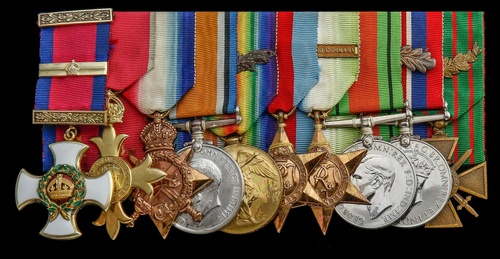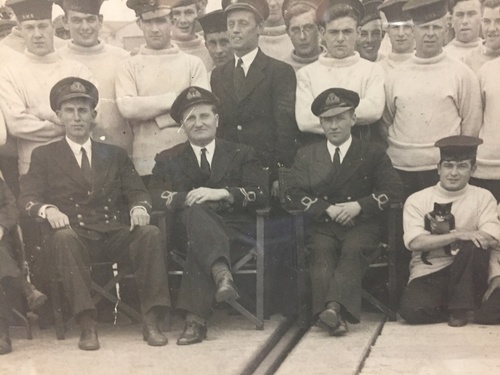Auction: 17003 - Orders, Decorations and Medals
Lot: 678
(x) A rare Great War minesweeping and mine recovery operations D.S.O. and Bar, 1940 minesweeping operations O.B.E. group of ten awarded to Captain G. W. H. Heaton, Royal Navy, a one-handed seadog who rounded off his operational career in his 60s as C.O. of H.M.S. Aggressive - the aptly named Coastal Forces base at Newhaven
Distinguished Service Order, G.V.R., with Second Award Bar, silver-gilt and enamel, the reverse of the suspension bar engraved 'Mine Sweeping 1st Jan 1916', the reverse of the integral top riband bar engraved 'Lt. Comdr. G. W. H. Heaton, R.N.', and the reverse of the Second Award Bar engraved 'Comdr. G. W. Heaton, D.S.O., R.N., U.C.44, Dunmore 4.8.17', integral top riband bar adapted for wear, with its Garrard & Co. case of issue; The Most Excellent Order of the British Empire, O.B.E. (Military) Officer's 2nd type breast badge, silver-gilt, with its Royal Mint case of issue; 1914-15 Star (Commr. G. W. H. Heaton, D.S.O., R.N.); British War and Victory Medals, M.I.D. oak leaf (Commr. G. W. H. Heaton, R.N.); 1939-1945 Star; Atlantic Star, clasp, France and Germany; Defence and War Medals 1939-45, M.I.D. oak leaf; France, Croix de Guerre 1914-1917, with palm, traces of lacquer, mounted court-style as worn, generally good very fine (10)
Just 49 D.S.O. and Bars were awarded to the Royal Navy in the Great War.
D.S.O. London Gazette 1 January 1916.
'In recognition of bravery and devotion to duty during mine-sweeping and mine-laying operations.'
Bar to D.S.O. London Gazette 7 June 1918:
'For skill and bravery shown by him in recovering enemy mines.'
The original recommendation - for recovering mines from the German submarine UC-44, beached on 30 September 1917 - states:
'For the skill shown in removing these mines from the tubes without accident. This officer has only one hand and yet, on a slippery, muddy deck he personally carried out the operations described, and seeing that an explosion of a mine due to excitement, loss of nerve or want of knowledge would have led to terrible casualties in the lifting lighters, the Snowdrop and Racer, and the adjoining village of Dunmore, I consider he should be well recompensed by a decoration.
Commander Heaton was placed in charge of the operation of removing the mines after the enemy submarine had been carried in and beached by the crew of the Admiralty salvage vessel.'
O.B.E. London Gazette 16 July 1940.
Gervase William Heaton Heaton was born in Brighton, Sussex on 3 March 1882, the son of G. W. Heaton and Annette Hannah, daughter of James Gordon Campbell, Indian Civil Service, late 9th Bengal Lancers.
Educated at Ascham House, Bournemouth, young Gervase entered the Royal Navy as a Cadet in Britannia in January 1896. As a Midshipman, he served on the Mediterranean Station, including employment in the operations in Crete in 1897-99. Advanced to Lieutenant in 1903, he commanded a number of destroyers before being placed on the Retired List as a Lieutenant-Commander at his own request in March 1912.
The Great War: one hand - two D.S.O.s
In March 1914, Heaton was badly injured in a motor accident in California, and his lower left arm had to be amputated at a point six inches below his elbow. Notwithstanding his injuries, he volunteered his services on the outbreak of hostilities and departed New York in the troopship - ex-Cunard liner - Franconia in early 1915.
Appointed 'additional for paddle sweepers' on his arrival in the U.K., he was given command of a flotilla in the Clyde in June 1915, and remained similarly employed until March 1916. Brought to the notice of Their Lordships for his 'bravery and devotion to duty' in minesweeping operations off Tory Island, off the north-west coast of Ireland, he was advanced to the acting rank of Commander and awarded the D.S.O., which distinction he received at Windsor Castle on 22 September 1916.
Meanwhile, in May 1916, Heaton had assumed command of H.M.S. Haldon, in which ship he was commended for valuable work in the period July 1917 to March 1917, and indeed on the occasion she struck a mine on 7 August 1917. He was mentioned in despatches (London Gazette 2 January 1917, refers) and awarded the French Croix du Guerre (London Gazette 2 November 1917, refers).
In September 1917, Heaton was appointed Principal Mine Service Officer at Queenstown, in which role he was awarded a Bar to his D.S.O. for his gallant deeds in recovering mines from the beached UC-44, when 'loss of nerve or want of knowledge would have led to terrible casualties in the lifting lighters, the Snowdrop and Racer, and the adjoining village of Dunmore'.
UC-44 had fallen victim to the detonation of one of her own mines off Dunmore on 4 August; her wreck was raised by the Royal Navy in the following month. In one of those strange twists of fate known to war, it later transpired that it was one UC-44's mines that had dealt a near-fatal blow to Heaton's old command, the Haldon.
At the year's end, he was given charge of a Patrol Area and he remained similarly employed until returning home to an appointment in the Ministry of Labour in early 1918. He was placed back on the Retired List in the rank of Commander at the war's end.
1939-45Recalled on the renewal of hostilities in September 1939, Heaton was appointed Naval Officer in Command (N.O.I.C.) of minesweeping craft at Lowestoft. Then in March 1940, he took command of H.M.S. Epping, an ex-L.N.E.R. vessel which had been converted for use as a minesweeper depot ship. About the same time, he was given the acting rank of Captain and took up duties as N.O.I.C. of Badger, the minesweeping base at Harwich, Essex. He was awarded the O.B.E., which distinction he received at Buckingham Palace on 6 August 1940.
'Aggressive'
In March 1941, Heaton was appointed to the command of H.M.S. Aggressive, the aptly named Coastal Forces base at Newhaven, Sussex, and he remained similarly employed until May 1945. Home to the 1st Steam Gun Boat (S.G.B.) Flotilla - which was long-commanded by Lieutenant-Commander Peter Scott, M.B.E., D.S.C., the son of Captain Robert Falcon Scott of Polar fame - Aggressive was to play an important role in the 'Battle of the Narrow Seas'.
Relentless - and punishing - anti-E-boat operations aside, Aggressive's S.G.B.s lent gallant service in the Dieppe raid and off Normandy in the summer of 1944. Resultant casualties were high, Heaton regularly bearing witness to the dead and wounded being landed at Newhaven after point-blank 'firefights' conducted in the Channel and off the Dutch coast.
By all accounts a stickler for discipline, his style of command inevitably clashed with the high spirits of his young "Wavy Navy" charges. Yet - as well-known to this cataloguer via his father who served in H.M. S.G.B. Grey Fox - Heaton's harsh style of command was a steadying hand in such challenging times. Moreover, as evidenced by his 'France and Germany' clasp, he joined his S.G.B.s on some of their countless forays to the Normandy beachhead in the summer of 1944; he was awarded 'Letter of Praise' by Their Lordships of the Admiralty.
He bade farewell to the 1st S.G.B. Flotilla in early 1945, when it was transferred to Dartmouth to undertake minesweeping duties, Their Lordships having ordained it needed a 'rest' after three years of constant action. Heaton - one of the Senior Service's most qualified minesweeping officers - no doubt imparted some useful words of advice.
He was placed back on the Retired List in September 1945 and died in March 1976; sold with copied research.
Subject to 5% tax on Hammer Price in addition to 20% VAT on Buyer’s Premium. For more information please view Terms and Conditions for Buyers.
Estimate
£3,000 to £3,500







